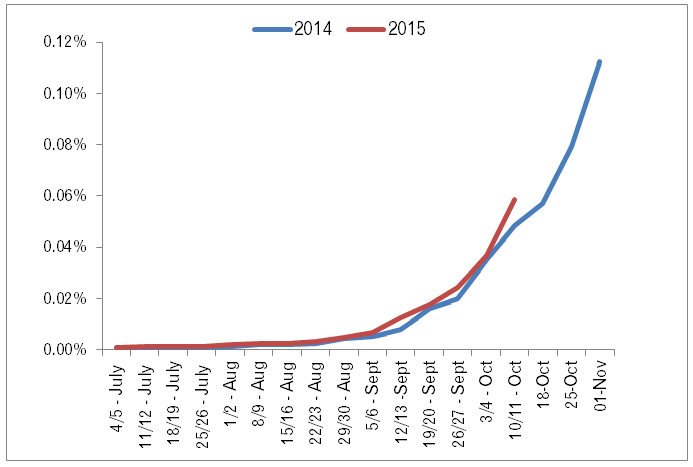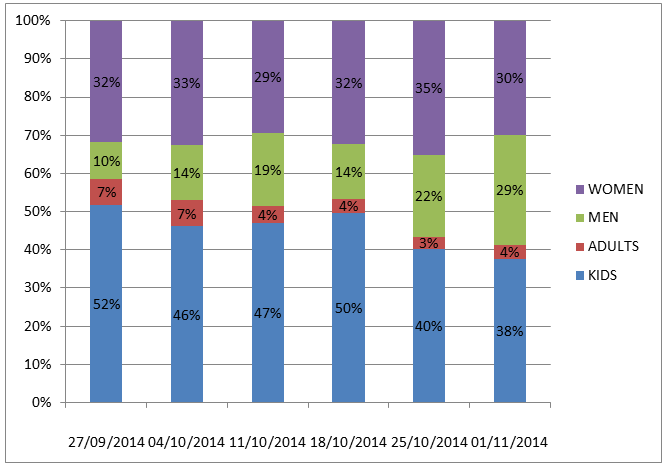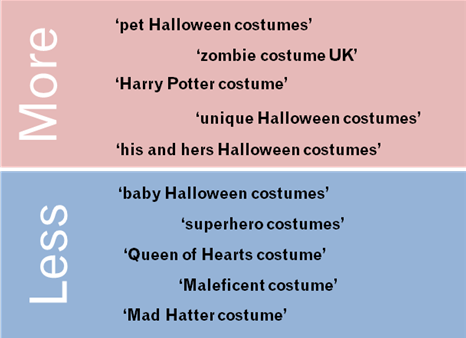Halloween spending in the UK last year was estimated to be £442m and a large part of this spending (34 per cent) was on costumes. This year, judging by their recent online behaviours, Britons are on track to spend even more. Therefore, it is vital for marketers to understand the season’s overall trends as well as the audiences seeking costumes and what they’ll be wearing so they can target them accordingly. To successfully manage campaigns this Halloween season, here are some need-to-know insights on consumer behaviour.
When looking at 2014 search data, the term ‘Halloween costumes’ began to increase in the week ending 20th September, however this year, consumers got an even earlier start and interest is, thus far, tracking ahead of levels observed last year. With searches continuing to grow until Halloween itself, there’s still plenty of time for marketers to capture the Halloween spirit in their digital campaigns.
Variations of ‘Halloween costume’ searches
Week ending 5th July 2014 – 1st November 2014 vs. week ending 4th July 2015 – 10th October 2015

Source: Experian’s Hitwise® online intelligence
Who is dressing up?
In the UK, it is not just the young who get involved with Halloween fancy dress, adults are equally—if not more likely—to take part. In fact, during the peak costume search period last year, searches for costumes or fancy dress for kids (ranging from newborns to teenagers) made up an average of 45 per cent of weekly search volume among variations that mentioned the age of the intended wearer. Meanwhile, searches for costumes for women made up roughly a third of weekly search volume—a rate that held fairly constant from week-to-week.
Men, on the other hand, accounted for an increasingly large share of weekly searches in the run up to Halloween. Specifically, during the week ending 11th October 2014, costumes for men represented 14 per cent of demographic-related searches. The week ending 25th October, that share had risen to 22 per cent and by the week of Halloween itself, costumes for men accounted for 29 per cent of searches. Clearly men tend to search for costumes later than women – most likely in a last minute panic.
What is interesting here is that marketers can track these patterns for the different age groups and make their campaigns relevant to the changing demographics of the audience each week.
Share of costume searches accounted for by key demographic groups
Week ending 27th September, 2014 – 1st November, 2015

Source: Experian’s Hitwise® online intelligence
What are people wearing?
An analysis of search variations of over 3,600 specific costumes reveals that superheroes and comic-inspired characters are this year’s top choices for costumes with ‘Harley Quinn’ being the most searched for costume in the UK for several weeks running. This is particularly interesting because it is a topical choice, with the character making her live-action cinematic debut in the film Suicide Squad scheduled for release in 2016. Several other Batman characters are also in the top 10, including Poison Ivy and Catwoman. Superheroes and other fictitious characters aside, ‘80s fancy dress’ comes in at number five overall this year and is the most popular period costume, although ‘70s’ and ‘90s fancy dress’ are also common.
Top specific costume/fancy dress search variations
Week ending 10th October 2015
- Harley Quinn costume
- Maleficent costume
- Stormtrooper costume
- Poison Ivy costume
- 80s fancy dress
- Mad Hatter costume
- Zombie costume
- Morticia Addams costume
- Superhero costumes
- Catwoman costume
Obviously, not everyone has the same taste in costumes and an additional analysis has revealed that affluent consumers (those who earn ₤55,000 annually) are less likely to be seeking out the most common costumes overall. Rather, they want something a bit more ‘unique’, something ‘his and hers’ or even a costume for their ‘pet’.
Costumes more and less popular among affluents
4 weeks ending 10th October 2015
Source: Experian’s AudienceViewTM platform
In order for marketers to create a successful Halloween campaign that is relevant and engaging, they must better understand the interests and behaviours of their unique audience. This will allow them to target the right people with the information they are interested in receiving, making it far more effective than if they didn’t have this additional data. In fact, that goes for Halloween as well as the other 364 days of the year.






